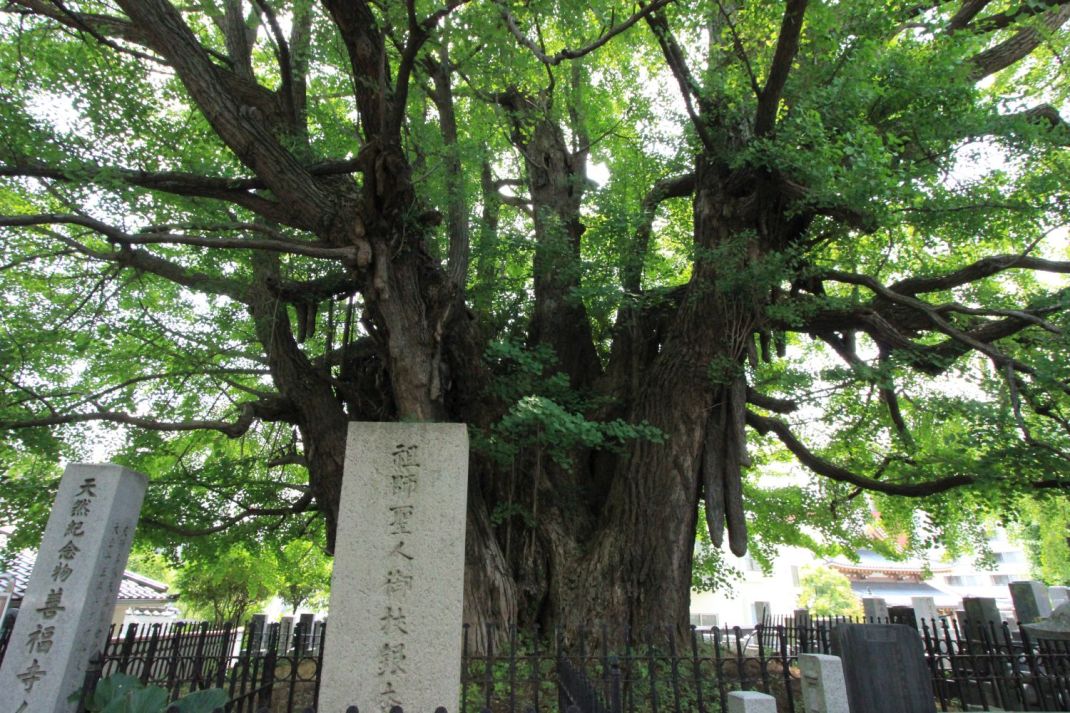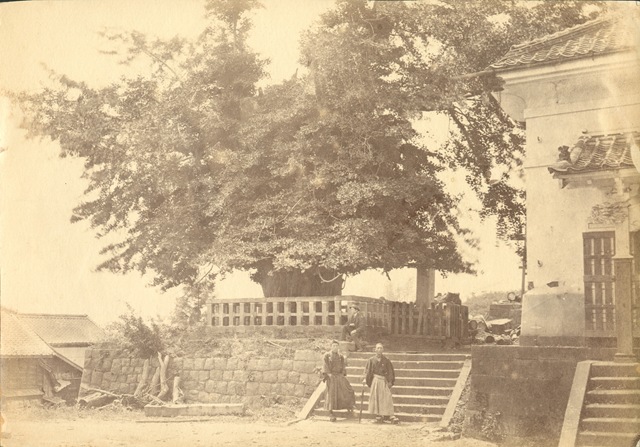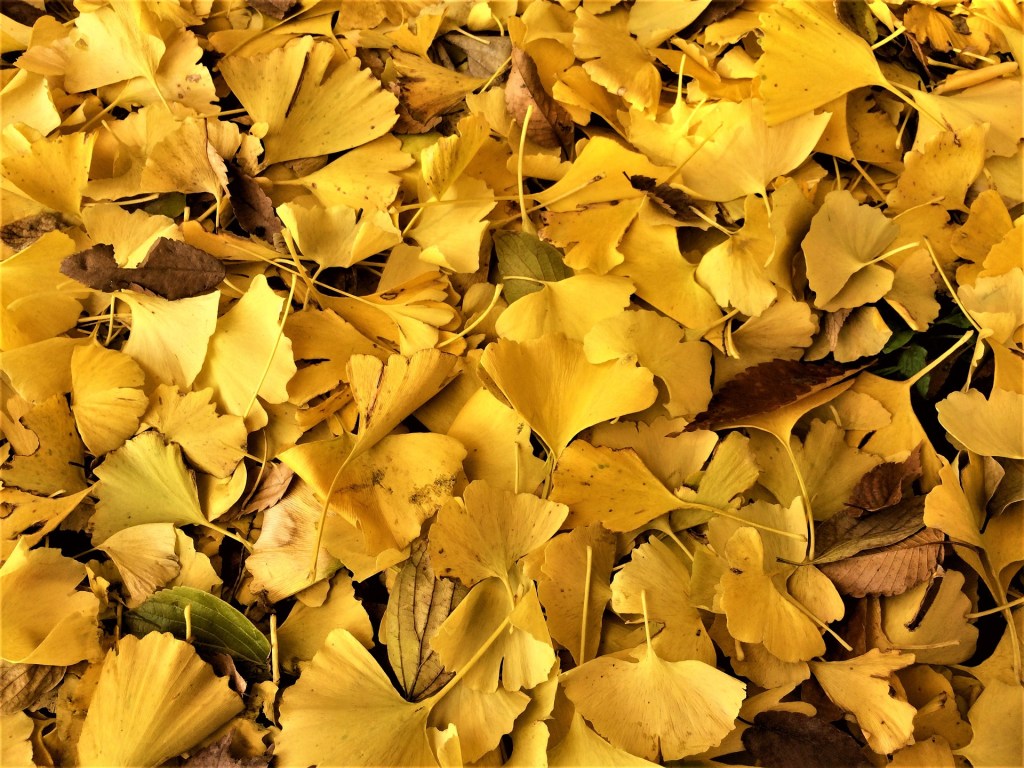Japan is a country in a careful balance between the new and the old. Nowhere is this more evident than the modern metropolis of Tokyo. Alongside the neon lights and constant hum of commuter trains, ancient temples and shrines provide a serene reminder of the past. Near the Zenpuku-ji Buddhist temple in the Azabu Ward, one ginkgo tree links to a time before time.

Sakasa Icho – the Inverted Ginkgo Tree – photo by Tiziano Rootman Fratus
Sakasa Icho, or the Inverted Ginkgo tree, is located in the temple cemetery. With an enormous 12 meter girth and 20 meter height, the tree is easily recognizable. The name comes from the aerial roots which hang down from its branches, giving the appearance that it’s growing downward.
Appreciation for nature is deeply ingrained in Japanese culture. The Inverted Ginkgo was designated as a ‘Natural Monument of Historic Sites and Places of Scenic Beauty’ back in 1926. At that time it was first recognized as the oldest tree in the city, planted around the year 1200 when Tokyo (then Edo) was just a small fishing village. Four centuries later Tokyo became the most significant city on the islands, when then Shogun Tokugawa Ieyasu made it the center of his government.
The Inverted Ginkgo survived countless fires and earthquakes that destroyed Tokyo’s traditional wooden houses of the city every 25-40 years, but the greatest challenge to its longevity would come during the Second World War.
On the evening of May 25, 1945, the Great Yamanote Air Raid devastated the city. It was the fifth and final air raid over Tokyo, and in Azabu Ward nearly 8000 houses were burnt to the ground. The Inverted Ginkgo survived, but lost its main trunk. That trunk will never grow back, but its age and size provided it with many branches from which to regrow, which it did without any human intervention. Ginkgo trees haven’t survived 200 million years by being weak.
That’s right, ginkgo trees originate in the early Jurassic period. When Chinese paleobotanist Zhou Zhiyan tested a 200 million year old ginkgo leaf fossil, he saw little difference from its modern counterpart. That’s 40 million years before the evolution of flowering plants (angiosperms or magnoliophyta), which now constitute the vast majority of plant varieties on the planet. Unlike angiosperms, ginkgo trees are the only species in their division (ginkgophyta), making them unlike any other surviving organism – a living fossil.

With fan shaped leaves and foul smelling fruit, it’s easy to imagine this prehistoric tree alongside the dinosaurs from the same period. But today, it lines city streets around the world. Tokyo has taken a particular liking to the tree, making it the official tree of the city, and its leaf the symbol.
Thousands of ginkgo trees can be found in the city, with more than 760 on Icho Namiki or ‘Ginkgo Avenue’ in Meiji-jingu Gaien Park. In mid Autumn, their green leaves will turn bright yellow and fall to the street, creating a golden glow.

Ginkgo Avenue in the Fall – photo by nakashi
If you enjoyed this article about Sakasa Icho, check out the archive for more tree stories. Also check out the Facebook page, with a few extra tree goodies throughout the week. Subscribe below to receive notifications whenever a new tree story is published.
As always, feel free to drop a comment below. It’s always nice to hear from you!
Further reading:
Click to access azabu_vol32.pdf
http://deepazabu.net/m1/7fusigi/7fusigi1.html
https://travelingilove.com/tokyo-oldest-ginkgo-tree/
http://e360.yale.edu/features/peter_crane_history_of_ginkgo_earths_oldest_tree





Interesting post, Nick.
It’s similar to the Banyan tree we talked about, a while back.
LikeLiked by 1 person
Thanks! It does have the same type of aerial roots! I’ll write about a banyan tree next week, I promise! 🙂
LikeLiked by 1 person
That fossil is so beautiful. Thank you for this site & your passion.
LikeLiked by 4 people
Thank you for the kind words!
LikeLiked by 1 person
It’s amazing that the trunk shown is not even its original! What it must have looked like pre-WWII!
LikeLiked by 2 people
Very nice, love it.
LikeLiked by 1 person
Although I imprinted on oaks at an early age, the ginkgo is a love that grows with the years. I remember reading about temple ginkgos in the Japanese cities that survived after being bombed in WW2. I remember with delight the trip to the Chicago Botanic Gardens in finding a stand of these beauties.
LikeLiked by 1 person
They really are spectacular! Certainly a memorable tree.
LikeLiked by 1 person
How interesting! I will look out for that special tree, and other ginkgos in Autumn.
LikeLiked by 1 person
What an amazing history. Thank you for sharing your knowledge.
LikeLiked by 1 person
Glad you enjoyed it!
LikeLiked by 1 person
Just came accrossed your site. It’s really amazed me that there’s so many about trees which I never knew.
LikeLiked by 1 person
I feel the same way! I write about one tree a week, but there are so many I will never get to.
LikeLiked by 1 person
Japan, history, and trees! I love it!
LikeLiked by 1 person
great job!
LikeLiked by 1 person
very good! keep it up!
LikeLiked by 1 person
Thank you!
LikeLike
Loved reading about this, I saw a tree with the fan shaped leaves at a tree festival here in northern California recently. Perhaps it was gingko 🙂 reminds me of Banyan trees in my native country of India.
LikeLiked by 1 person
Thanks for the kind words! I’m actually going to publish an article about a banyan tree in India tomorrow, so stay tuned! 🙂
LikeLiked by 1 person
Pingback: Tokyo Weeks 11 & 12: Sayonara, Tokyo! – Atlas & Alphabet